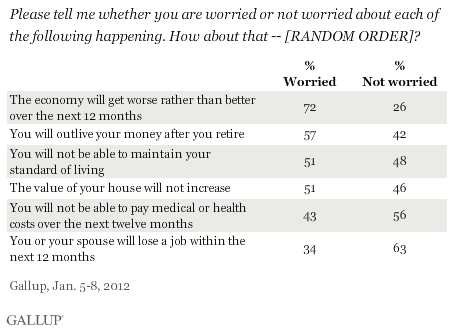PRINCETON, NJ -- Americans' worries about maintaining their standard of living (51%), or being able to pay medical bills (43%) or losing their job (34%) in the next 12 months are among the highest Gallup has measured in the past 20 years, on par with the levels seen in 1991 and 1992.

These results are based on a Jan. 5-8 Gallup poll. Since 1991, Gallup has periodically asked Americans whether they are worried about each of these financial events happening to them. The trend includes updates in January of four presidential election years -- 1992, 2004, 2008, and 2012.
Americans' economic anxiety today is most similar to what it was in 1992, though Americans are slightly less worried about not being able to pay medical bills now (43%) than they were then (48%). The economic angst at that time helped contribute to George H.W. Bush's re-election defeat that year. Far fewer were worried in 2004, when George W. Bush won a second term.
The late January/early February 2008 survey was conducted as the U.S. was in the beginning of an economic recession and Americans were becoming increasingly worried about the economy, but before the financial crisis unfolded later that year. Americans were less worried at that time than they are now about losing a job (23% versus 34%) and paying medical bills (33% versus 43%), but about as worried about not being able to maintain their standard of living (50% versus 51%).
Gallup did not ask this question in the immediate aftermath of the financial crisis, so it's possible the levels of financial worry were higher then. However, the January 2011 update showed that economic concerns were elevated in all three areas nearly two years after the recession officially ended. Importantly, Americans' financial concerns remain high even as economic confidence is improving.
Americans Worry Most About National Economy
The poll also included three items -- worry about home values not increasing, worry about outliving one's money after retiring, and worry that the economy will get worse in the next year -- in addition to the core items that date to 1991.
Of the six items, Americans are most worried that the economy will get worse, at 72%, followed by outliving their money in retirement (57%). The 51% worried about home values not increasing matches the percentage worried about not being able to maintain their standard of living.

Lower-income Americans express more worry than upper-income Americans about being able to maintain their standard of living, being able to pay medical bills, and job loss. However, lower- and upper-income Americans show surprisingly similar levels of worry about their home values and outliving their money in retirement.

The lack of income differences in worry about housing values may result from the likelihood that many lower-income Americans are renting their homes or perhaps are disproportionately older Americans who have paid off their mortgages.
Implications
Americans continue to express concerns about their financial situations, with half worried about maintaining their standard of living, 4 in 10 worried about being able to pay medical costs, and one in three worried about losing a job. A separate Gallup question found roughly half of Americans saying they are financially worse off now than a year ago.
To a large degree, Americans' level of economic worry is similar to what it was in 1992, when Americans denied Bush a second term in office. President Obama remains vulnerable to defeat, with approval ratings still in the mid-40% range. One difference between Bush and Obama, however, is that Obama was elected during a sluggish economy while Bush took office during healthy economic times. Still, voters may hold Obama accountable if they perceive that conditions have not improved much in four years.
Survey Methods
Results for this Gallup poll are based on telephone interviews conducted January 5-8, 2012, with a random sample of 1,011 adults, aged 18 and older, living in all 50 U.S. states and the District of Columbia.
For results based on the total sample of national adults, one can say with 95% confidence that the maximum margin of sampling error is ±4 percentage points.
Interviews are conducted with respondents on landline telephones and cellular phones, with interviews conducted in Spanish for respondents who are primarily Spanish-speaking. Each sample includes a minimum quota of 400 cell phone respondents and 600 landline respondents per 1,000 national adults, with additional minimum quotas among landline respondents by region. Landline telephone numbers are chosen at random among listed telephone numbers. Cell phone numbers are selected using random-digit-dial methods. Landline respondents are chosen at random within each household on the basis of which member had the most recent birthday.
Samples are weighted by gender, age, race, Hispanic ethnicity, education, region, adults in the household, and phone status (cell phone only/landline only/both, cell phone mostly, and having an unlisted landline number). Demographic weighting targets are based on the March 2011 Current Population Survey figures for the aged 18 and older non-institutionalized population living in U.S. telephone households. All reported margins of sampling error include the computed design effects for weighting and sample design.
In addition to sampling error, question wording and practical difficulties in conducting surveys can introduce error or bias into the findings of public opinion polls.
View methodology, full question results, and trend data.
For more details on Gallup's polling methodology, visit www.gallup.com.
